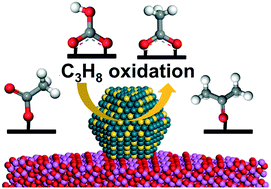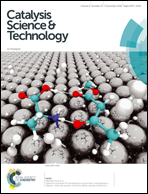Catalytic oxidation of propane over palladium alloyed with gold: an assessment of the chemical and intermediate species†
Abstract
Understanding the catalytic oxidation of propane is important for developing catalysts not only for catalytic oxidation of hydrocarbons in emission systems but also for selective oxidation in the chemical processing industry. For palladium-based catalysts, little is known about the identification of the chemical or intermediate species involved in propane oxidation. We describe herein findings of an investigation of the catalytic oxidation of propane over supported palladium nanoalloys with different compositions of gold (PdnAu100−n), focusing on probing the chemical or intermediate species on the catalysts in correlation with the bimetallic composition and the alloying phase structure. In addition to an enhanced catalytic activity, a strong dependence of the catalytic activity on the bimetallic composition was revealed, displaying an activity maximum at a Pd : Au ratio of 50 : 50 in terms of reaction temperature. This dependence is also reflected by its dependence on the thermochemical treatment conditions. While the activity for nanoalloys with n ∼ 50 showed little change after the thermochemical treatment under oxygen, the activities for nanoalloys with n < 50 and n > 50 showed opposite trends. Importantly, this catalytic synergy is linked to the subtle differences of chemical and intermediate species which have been identified for the catalysts with different bimetallic compositions by in situ measurements using diffuse reflectance infrared Fourier transform spectroscopy (DRIFTS). For the catalytic oxidation of propane over the highly-active catalyst with a Pd : Au ratio of 50 : 50, the major species identified include acetate and bicarbonate, showing subtle differences in comparison with the identification of bicarbonate and formate for the catalyst with <50% Au (with a lower activity) and the absence of apparent species for the catalyst with >50% Au (activity is largely absent). The alloying of 50% Au in Pd is believed to increase the oxophilicity of Pd, which facilitates the first carbon–carbon bond cleavage and oxygenation of propane. The implications of the findings on the catalytic synergy of Pd alloyed with Au and the design of active Pd alloy catalysts are also discussed.



 Please wait while we load your content...
Please wait while we load your content...